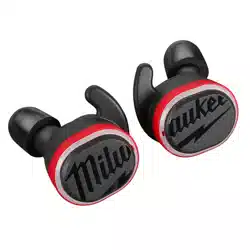Loading ...

2
IMPORTANT SAFETY
INSTRUCTIONS
- SAVE THESE
INSTRUCTIONS -
WARNING
READ AND UNDERSTAND ALL
INSTRUCTIONS. Failure to follow
all instructions listed below, may result in electric
shock, re and/or serious personal injury.
1. SAVE THESE INSTRUCTIONS - This manual
contains important safety and operating in-
structions for the REDLITHIUM™ USB battery
and USB Bluetooth
®
Jobsite Earbuds.
2. Before using the battery and USB Bluetooth
®
Jobsite Earbuds, read the operator's manual
and all labels on the battery and USB Bluetooth
®
Jobsite Earbuds case.
3.
CAUTION
Use and charge only
REDLITHIUM™ USB batteries in
the USB Bluetooth
®
Jobsite Earbuds case. Do
not use counterfeit, aftermarket, or "knocko"
batteries or chargers. Do not wire a battery
pack to a power supply plug or car cigarette
lighter.
4. Use only with Listed/Certied ITE power sup-
ply.
5. Avoid dangerous environments. Do not charge
battery in rain, snow, damp or wet locations. Do
not use battery or charger in the presence of
explosive atmospheres (gaseous fumes, dust
or ammable materials) because sparks may be
generated when inserting or removing battery,
possibly causing re.
6. Charge in a well ventilated area. Do not allow
smoking or open ames near a charging battery.
Vented gases may explode.
7. Maintain charger cord. When unplugging
charger, pull plug rather than cord. Never carry
charger by its cord. Keep cord from heat, oil and
sharp edges. Make sure cord will not be stepped
on, tripped over or subjected to damage or stress.
Do not use charger with damaged cord or plug.
Have a damaged charger replaced immediately.
8. Use only recommended attachments. Use of
an attachment not recommended or sold by the
battery charger or battery manufacturer may result
in a risk of re, electric shock or personal injury.
9. Unplug charger and remove battery packs
when not in use.
10. Always unplug charger before cleaning or
maintenance. Do not allow water to ow into AC/
DC plug. Use a Ground Fault Circuit Interrupter
(GFCI) to reduce shock hazards.
11. Do not burn or incinerate batteries. Battery
may explode. Toxic fumes and materials are
created when battery are burned.
12. Do not crush, drop, or damage battery pack.
Always securely contain battery packs during
transport. Do not use a battery pack that has
received a sharp blow, been dropped, run over, or
damaged in any way (e.g., pierced with a nail, hit
with a hammer, stepped on, in a vehicle accident).
Do not use or charge batteries that appear dam-
aged or swollen, or are not functioning properly.
13. Do not disassemble. If it is damaged, take it to
a MILWAUKEE service facility.
14. Battery chemicals cause serious burns.
Never allow contact with skin, eyes, or mouth. If
a damaged battery leaks battery chemicals, use
rubber or neoprene gloves to dispose of it. If skin
is exposed to battery uids, wash with soap and
water and rinse with vinegar. If eyes are exposed
to battery chemicals, immediately ush with wa-
ter for 20 minutes and seek medical attention.
Remove and dispose of contaminated clothing.
15. Do not short circuit. A short-circuited battery
pack may cause re, personal injury, and product
damage. A battery pack will short circuit if a metal
object makes a connection between the positive
and negative contacts on the battery pack. Do
not place a battery pack near anything that may
cause a short circuit, such as coins, keys or nails
in your pocket.
16. Do not allow uids to ow into battery pack.
Corrosive or conductive uids, such as seawa-
ter, certain industrial chemicals, and bleach or
bleach containing products, etc., can cause a
short circuit.
17. Store your battery pack in a cool, dry place. Do
not store battery where temperatures may exceed
120°F (50°C) such as in direct sunlight, a vehicle,
or metal building during the summer.
18. To reduce the risk of injury, close supervi-
sion is necessary when an appliance is used
near children.
19. Maintain labels and nameplates. These carry
important information. If unreadable or missing,
contact a MILWAUKEE service facility for a free
replacement.
SPECIFIC SAFETY
RULES
WARNING
Read all safety warnings, instruc-
tions, illustrations and specica-
tions provided. Save all warnings and instruc-
tions for future reference.
•Failure to follow these instructions can result in
hearing loss or injury.
•These earbuds can help reduce exposure to
hazardous noise and loud sounds.
•Misuse, improper t, or failure to wear hearing
protectors during all exposure may result in
hearing loss or injury.
•Inspect before use and discard if ear tip silicone/
foam tips are cracked, torn, dirty, hard, or de-
formed. Ear tips should be clean and soft before
use. Damaged ear tips could break in ear canal.
• Do not expose your battery or cordless tools
to water or rain, or allow them to get wet. This
could damage the tool and battery.
•If you experience ringing or buzzing in your ears,
or your hearing seems dulled, your hearing may
be at risk. Consult a physician if you suspect
hearing loss.
•Consult with a physician before wearing hearing
protection if you have drainage from your ears
or an ear infection.
•If using as hearing protection, only use these
earbuds if a good t can be obtained. If not, use
another type of hearing protection.
• Extended exposure to high volumes can result in
hearing damage. Recommended volume for ex-
tended use is 85dBA or lower for 8 hours or less.
Loading ...
Loading ...
Loading ...
